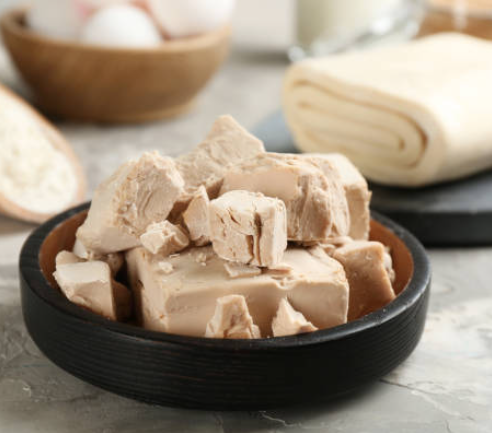What Is A Leavening Agent?
What is a leavening agent is a question you might ask if you are thinking about making home made bread.
A leavening agent is a material that causes doughs and batters to expand by releasing gases from within the mixture, resulting in porous baked goods. Air, steam, yeast, baking powder, and baking soda are examples of such leavening agents.
The word ‘leavening’ means ‘making light,’ and it refers to the process of adding gas bubbles to your dough to help it rise or to your batter to make it rise.
How do leavening agents work?
Gliadin and glutenin are two proteins found in wheat flour, which are used to make dough. When you add water and begin mixing, the gliadin and glutenin combine to make gluten, a new protein. Gluten molecules form chains that can be quite long and supple. This flexibility is what allows you to stretch a piece of bread dough between your fingers. It gets stretchier the more you knead it.

The gas created by the leavening chemical causes the dough to inflate by forming hundreds of little bubbles. Imagine a swarm of thousands of tiny balloons being inflated with air. Like balloons, your dough is flexible. If it wasn’t, blowing up a balloon would be the same as blowing into a glass of water with a straw: the bubbles would burst and the gas would escape. The bubbles expand without breaking due to the dough’s elasticity, allowing the gas to remain trapped in the bubbles long enough for the third stage of the process to occur.
While those little bubbles are in their expanded state, the heat of the oven cooks the dough, causing it to solidify. As a result, when the gas finally escapes, the air pockets retain their shape rather than collapsing. The texture of your baked item is determined by the size of those air pockets. A silky texture, similar to that of a cake, is created by little air pockets. Larger ones result in a coarser texture, similar to that of crusty bread.
 What are the three most common chemical leavening agents used in baking?
What are the three most common chemical leavening agents used in baking?
The three most common chemical leaving agents are baking soda, baking powder, and cream of tartar, which are all important leavening agents in baked goods.
The first thing to know about baking soda and baking powder is that they are not interchangeable. Baking soda is contained in baking powder, however the two are not interchangeable. So, what exactly are they?
Baking Soda
Baking soda, also known as sodium bicarbonate, is a salt formed by combining carbon, sodium, hydrogen, and oxygen molecules. When combined with an acid, it is used to leaven doughs and batters chemically. When baking soda is combined with an acid, a chemical reaction occurs, releasing carbon dioxide gas, causing the food to expand and become fluffy. Consider soft and fluffy pancakes. At work, that’s the baking soda. If you have dense rocks for pancakes, on the other hand, your baking soda may not be working.
This method differs from using yeast to leaven bread since yeast is a biological process because it is a live organism that produces carbon dioxide gas by digesting the carbohydrates in the batter. Yeast is a living organism. Baking soda isn’t one of them. However, both increase product prices by emitting carbon dioxide gas, albeit in different ways.
Baking soda is also shelf stable for a long time because it is not a living entity. It is not necessary to keep it chilled. In fact, baking soda for cooking should not be placed in the refrigerator because it will absorb any orders that persist there. Now, while this is a fantastic usage for baking soda, it should not be used in baking or cooking.
Baking soda usually has an expiration date of 18 to 24 months, but you can always verify its efficacy by combining 1 1/2 teaspoons baking soda with 1 tablespoon vinegar in a basin. Even if it fizzes, it can still be used.
Remember that when baking soda is exposed to acids (buttermilk, vinegar), it becomes reactive and must be utilized straight away, otherwise the carbon dioxide-producing bubbles may explode, resulting in a flat and dense product rather of something light and airy. As a result, it’s probably not a good idea to produce and keep a batter for an extended period of time. It’s best to use it right soon (or within an hour), especially after combining the baking soda and acidic component. You’ll also want to mix batters softly to protect those bubbles. Bubbles will break as a result of vigorous mixing.
Baking Powder – What is a leavening agent?
Baking soda and powdered acids make up this component. Because it already includes acid, it’s generally seen in recipes that don’t call for any additional acids. It raises goods by creating carbon dioxide gas, just like baking soda, but it does so in two stages. When the baking soda in the powder and one of the acids are mixed with moist substances, they begin to produce carbon dioxide bubbles. When exposed to heat above 170°F, the other powdered acid combines with the remaining baking soda, resulting in the formation of additional bubbles.
Double-acting is the name for this two-phase rising process. Single-acting baking powders are available; these powders rise only once throughout the baking process’ heating stage. If single-acting baking powder is required, your recipe will specify it. The majority of baking powders are double-acting.
You can test it, just like baking soda, to check if it’s still effective. In a small bowl, combine one teaspoon baking powder and one tablespoon warm water. If the baking powder does not bubble when mixed with water, it is no longer active and should be discarded.
Baking powder, like baking soda, is normally marked with a “best by” range of 18 to 24 months, but if it is not contaminated, it will last indefinitely. When the same measuring scoop is used to measure other ingredients before measuring the baking powder, contamination occurs.
What if you don’t have any baking powder? You can make your own from scratch. 1/4 teaspoon baking soda, 1/2 teaspoon cream of tartar, and 1/4 teaspoon cornstarch in place of 1 teaspoon baking powder OR 1/4 teaspoon baking soda with 1/2 cup buttermilk, sour milk, or yogurt in place of 1 teaspoon baking powder (To make this replacement, reduce the liquid in the recipe by half.)
Cream of Tartar – what is a leavening agent
It’s not a cream, and it has nothing to do with the tartar that one hears about during dental checkups. So, what exactly is it? It’s a byproduct of the winemaking process. A powdery material remains after wine has been brewed and matured in barrels. Cream of tartar is made from this material, which is harvested, cleaned, and sold.
It’s mostly an acid. It’s one of the powdered acids included in baking powder, which helps leaven baked goods. It also helps egg whites maintain their structure so they don’t deflate as rapidly, which is useful when preparing meringues.
It’s not commonly used in recipes, so it’s not usually a pantry essential unless you bake frequently. 1 1/2 teaspoons lemon juice or vinegar is a good substitute.
All of these items should be kept in their original containers and stored in a cold, dry location away from your stove. Cooking’s heat and moisture may cause them to change chemically.
SIDEBAR:
Here is a great video about leavening agents:
To explore the science of leaving agents read this article.
For more baking basics visit our “Baking Basics” section.

